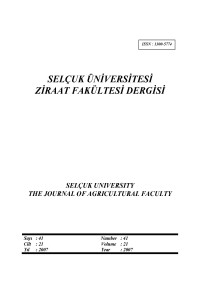The Causes of Drying Originated From Abiotik and Biotik Reasons on Turfgrass in The Green Areas in Konya
Öz
ABSTRACT
This search is carried out in order to find out the causes and ratio of drying on turfgrass in Konya. In the process of the research, surveys on the green areas were held between the years 2003 and 2004. As a consequence of these surveys, it is determined that the factors causing drying of the turfgrass on the green areas in Konya are originated from abiotic and biotic reasons. Where as delayed reaping deficiency of phosphorus, human causing harm, insufficient or excessive irragation, using scythe to cut the grass and the indirect harms of cutting machines have been accepted as the biotic factors resulting in drying on turfgrass, Fusarium culmorum, Fusarium equiseti, Fusarium oxysporum, Fusarium solani, Rhizoctonia solani, Pythium sp. and Dreschlera sp. have been considered as biotic based reasons.
It is observed that there is drying on 33 different turfgrass locasion due to both abiotic and biotic reasons. Mean while, the ratio of the dried areas to the total turfgrass areas was recorded as 0.62 % in 2003 and as 0.77 % in 2004. The general dry-ing ratio was found as % 0.69.
As a result of isolation made to determine the biotic results of drying, 6 species belonging to 17 different genus have been identified. As a consequence of pathogenicity tests on seven of these fungi, it was found that all these seven species are pathogen. According to these pathological tests, the severity of diseases on turfgrass are measured as as 99.4 %, 99.22 %, 98.95 %, 94.77 %, 93.02 %, 67.40 % ve 62.90 %. These measurements respectively belong to Fusarium culmorum, Fusarium solani, Fusarium oxysporum, Rhizoctonia solani, Dreschlera sp., Pythium sp., Fusarium equiseti.
Anahtar Kelimeler
Öz
Bu çalışma Konya İli yeşil alanlarındaki çimlerde gözlenen kurumaların sebeplerini ve oranını belirlemek amacıyla yapıl-mıştır. Bunun için 2003 ve 2004 yıllarında çim alanlarında surveyler yapılmıştır. Yapılan surveyler sonucu Konya İli yeşil alanlarındaki çimlerde kurumaya neden olan etkenlerin abiotik ve biotik kaynaklı olduğu tespit edilmiştir. Geç biçim, fosfor noksanlığı, insan zararı, az ve aşırı sulama, tırpanla biçim ve biçim makinelerinin endirekt zararları çimlerde kurumalardan sorumlu abiotik etkenler olarak belirlenirken, Fusarium culmorum, Fusarium equiseti, Fusarium oxysporum, Fusarium solani, Rhizoctonia solani, Pythium sp., Dreschlera sp. gibi fungal organizmaların neden olduğu kurumalar ise biotik kaynaklı olarak saptanmıştır.
Hem abiotik hem de biotik nedenlerden dolayı 33 farklı çim lokasyonun da kuruma gözlenirken kuruyan alanların toplam çim alanlarına oranı 2003 yılında % 0,62, 2004 yılında %0.77 olarak bulunmuştur. Genel kuruma oranı ise %0.69 olarak tespit edilmiştir.
Biotik kaynaklı kurumaların nedenlerini saptamak için çimlerden yapılan izolasyonlar sonucu 17 farklı genusa ait 12 tür tespit edilmiştir. Tespit edilenlerden 7’si ile yapılan patojenisite testleri sonucu yedisininde çim bitkilerinde patojen oldukları bulunmuştur. Patojenisite testlerinde % 99.4, % 99.22, % 98.95, % 94.77, % 93.02, % 67.40 ve % 62.90 oranında ölçülen hastalık şiddeti değerlerinin sırasıyla Fusarium culmorum, Fusarium solani, Fusarium oxysporum, Rhizoctonia solani, Dreschlera sp., Pythium sp. ve Fusarium equiseti ’ye ait olduğu bulunmuştur.
Ayrıntılar
| Birincil Dil | İngilizce |
|---|---|
| Konular | Bitki Bilimi |
| Bölüm | Araştırma Makalesi |
| Yazarlar | |
| Yayımlanma Tarihi | 25 Nisan 2007 |
| Gönderilme Tarihi | 1 Ocak 2007 |
| Yayımlandığı Sayı | Yıl 2007 Cilt: 21 Sayı: 41 |
Kaynak Göster
Selcuk Journal of Agriculture and Food Sciences Creative Commons Atıf-GayriTicari 4.0 Uluslararası Lisansı (CC BY NC) ile lisanslanmıştır.

